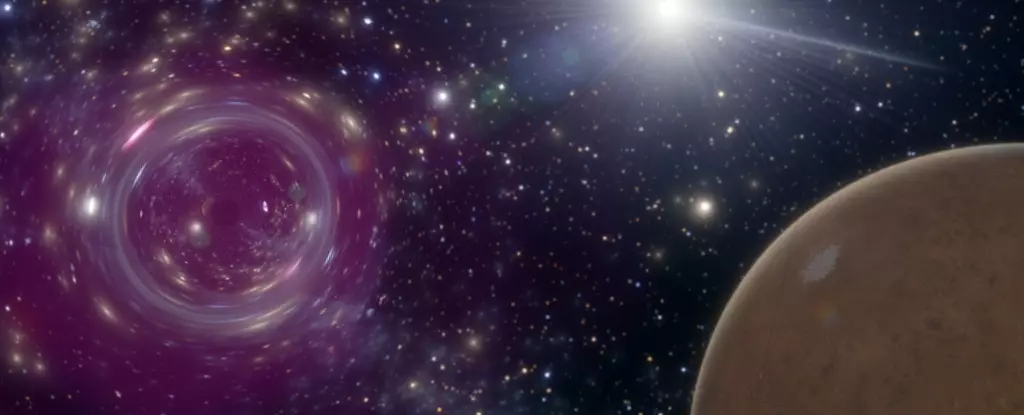Tiny primordial black holes (PBHs) may be navigating through our Solar System more frequently than previously imagined, with recent studies suggesting these cosmic anomalies could pass by as often as once every decade. The intriguing concept of PBHs stems from their theoretical formation during the universe’s infancy, within the chaotic moments occurring in the first seconds after the Big Bang. These miniature black holes, born through the gravitational collapse of dense, ionized regions of matter, might be key to unlocking the complex enigma of dark matter, an invisible substance that astronomers have struggled to fully understand.
A groundbreaking investigation led by physicists in the United States aimed to estimate the frequency of these primordial wanderers and their potential influence on celestial bodies within our vicinity. The team posited that PBHs, each approximately the mass of an asteroid compressed into an atomic-scale volume, could actually traverse the inner Solar System approximately every ten years. While outright visibility might be a challenge—these elusive entities do not emit light—they could still exert gravitational effects detectable through subtle alterations in the orbits of planets, such as Mars.
The research indicates that if a PBH were to come within a range of around 450 million kilometers (approximately 280 million miles) from Mars, it would induce a measurable wobble in the planet’s orbit. Though the predicted shift might seem minimal—just one meter (3.3 feet) over a decade—modern astronomical instrumentation allows us to track Mars’s position with remarkable precision, within ten centimeters (4 inches). This capability opens up new avenues for employing celestial mechanics to discern the presence of PBHs.
At the heart of this investigation lies a thought-provoking hypothetical scenario: What would transpire if a PBH passed extraordinarily close to a human being? Lead author Tung Tran, an astrophysicist at the Massachusetts Institute of Technology (MIT), computed that an encounter at a distance of merely one meter could result in a dramatic displacement, potentially flinging a person approximately six meters away within just one second. While this scenario is highly improbable, it fueled curiosity about how such cosmic phenomena would interact with the planets and their corresponding moons in our Solar System.
Tran’s team extrapolated further to assess the impact of a PBH near Earth, theorizing potential wobbles in the Moon’s orbit. However, the calculations yielded complex outcomes, complicating the quest to establish a clear signature from such interactions. The inherent dynamics of the Solar System, influenced by numerous factors, could dissipate or obscure the signal generated by the passage of a PBH.
To gain better insight into potential PBH encounters, the researchers conducted simulations focusing on Mercury, Venus, and Mars. Among these planets, Mars emerged as the most promising candidate for detecting the effects of a PBH flyby, primarily due to ongoing monitoring and an established array of scientific instruments. The investigation drew attention to the fundamental differences between the interactions of PBHs and that of other celestial bodies, such as asteroids, which follow more gradual trajectories and exert influence over extended periods.
While asteroids and PBHs both impact gravitational dynamics, their behavioral patterns diverge significantly. Asteroids tend to travel at slower velocities and exist within consistent orbits around the Sun, producing blending interactions that occur over time. In contrast, PBHs race through the Solar System at speeds reaching up to 200 kilometers per second, yielding sharp, discrete gravitational signatures that stand out against the cosmic backdrop.
The research team emphasizes the need for further investigations that incorporate a wider array of celestial objects, understanding their respective velocities and distributions may clarify how PBHs interact with the solar environment. Without robust comparative models outlining backgrounds, including typical space rocks, distinguishing PBH effects from the everyday dance of asteroids could prove challenging.
The pursuit for deeper insight into primordial black holes continues, with the thrilling prospect that astronomers could eventually witness the subtle Martian wobbles induced by these enigmatic entities. Such observations could provide pivotal evidence, helping unravel one of the most significant mysteries associated with the universe’s dark matter composition and enhancing our understanding of cosmic origins. The potential for PBHs to reshape our comprehension of the cosmos serves as a reminder that even amidst the vastness of space, there remains much to explore.


Leave a Reply